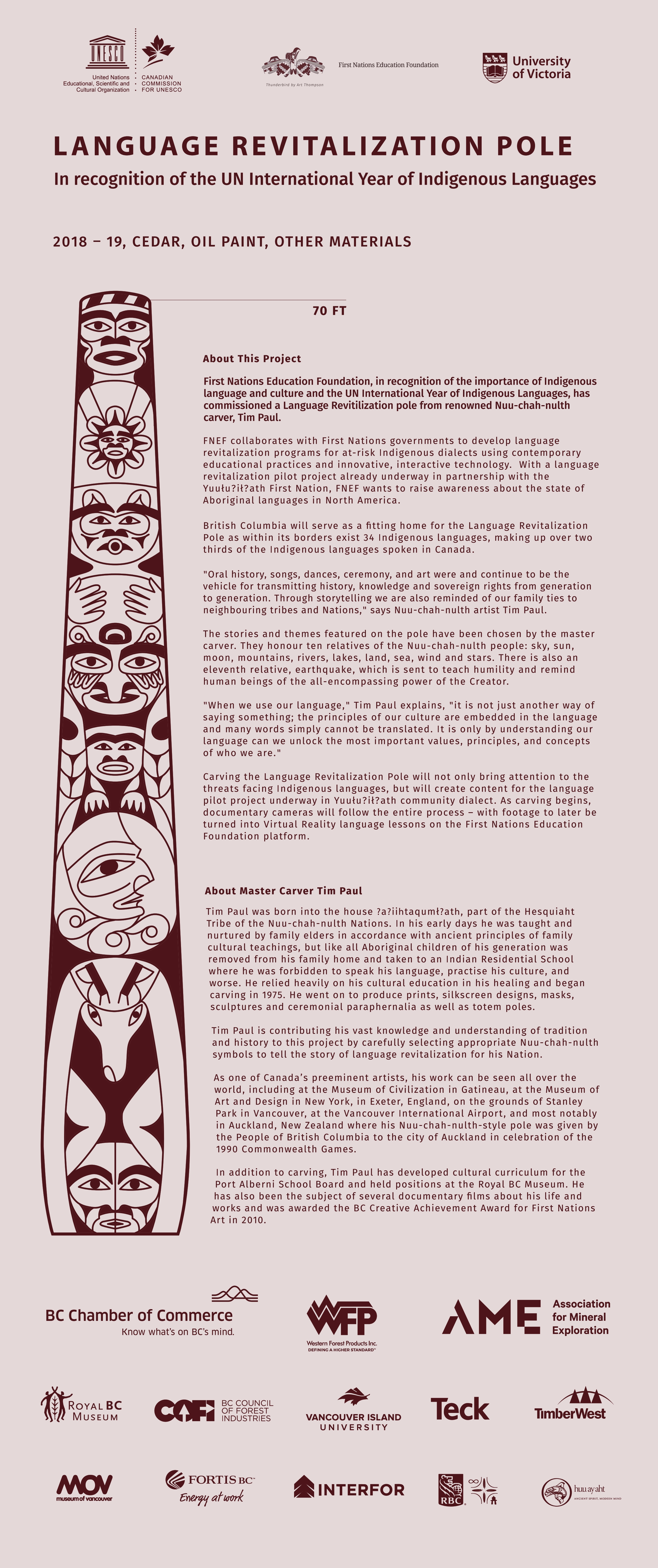
LANGUAGE REVITALIZATION POLE – CARVING & CREATION
About This Project
First Nations Education Foundation, in recognition
of the importance of Indigenous language and
culture and the 2019 UN International Year of
Indigenous Languages, has commissioned a
Language Revitalization totem pole from renowned
Nuu-chah-nulth carver, Tim Paul.
FNEF collaborates with First Nations governments to
develop language revitalization programs for at-risk
Indigenous dialects using contemporary educational
practices and innovative, interactive technology.
With a language revitalization pilot project already
underway in partnership with the Yuułu?ił?ath First
Nation, FNEF wants to raise awareness about the
state of Aboriginal languages in North America.
British Columbia will serve as a fitting home for the
Language Revitalization Pole as within its borders
exist 34 Indigenous languages, making up over two
thirds of the Indigenous languages spoken in
Canada.
“Oral history, songs, dances, ceremony, and art
were
and continue to be the vehicle for transmitting history,
knowledge and sovereign rights from generation to
generation. Through storytelling we are also reminded
of our family ties to neighbouring tribes and
Nations,”
says Nuu-chah-nulth artist Tim Paul.
The stories and themes featured on the pole have
been chosen by the master carver. They honour ten
relatives of the Nuu-chah-nulth people: sky, sun,
moon, mountains, rivers, lakes, land, sea, wind and
stars. There is also an eleventh relative,
earthquake, which is sent to teach humility and
remind human beings of the all-encompassing
power of the Creator.
“When we use our language,” Tim Paul
explains, “it is
not just another way of saying something; the
principles of our culture are embedded in the
language and many words simply cannot be
translated. It is only by understanding our language
can we unlock the most important values, principles,
and concepts of who we are.”
Carving the Language Revitalization Pole will not only
bring attention to the threats facing Indigenous
languages, but will create content for the language
pilot project underway in Yuułu?ił?ath community
dialect. As carving begins, documentary cameras will
follow the entire process – with footage to later be
turned into Virtual Reality language lessons on the
First Nations Education Foundation platform.
About Filmmaker Dale Devost
Dale Devost has been behind a camera for over 30
years. His programs have been broadcast on CBC,
APTN, and Knowledge Network and he has produced
numerous documentaries including two projects that
feature master carver Tim Paul: Dr. George Clutesi
Curriculum Project and New Moon a Gift for the Spirit.
Devost has been running his own production company
out of his home on Hornby Island since 1985, with a
focus on telling stories of cross-cultural
understanding, arts, and the environment.
For more information about the Pole and language
revitalization please visit: www.fnef.ca
